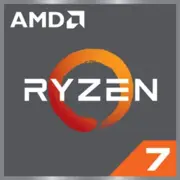AMD Ryzen 7 7435HS

The AMD Ryzen 7 7435HS processor is an impressive addition to the AMD lineup, featuring the latest Zen 3+ (Rembrandt) architecture and built on a cutting-edge 6nm process. With a total of 8 cores and 16 threads, this processor offers exceptional multi-threaded performance for demanding tasks such as content creation, video editing, and gaming.
The base frequency of 3.1 GHz and a max turbo frequency of 4.5 GHz ensures snappy performance across a wide range of applications. The large 16MB L3 cache also helps to keep the processor running smoothly even under heavy workloads. The TDP of 35-54W strikes a good balance between performance and power efficiency, making it suitable for use in high-performance laptops.
In benchmark tests, the AMD Ryzen 7 7435HS performs admirably, with a Geekbench 6 single-core score of 1969 and a multi-core score of 9984. These scores demonstrate the processor's ability to handle both single-threaded and multi-threaded workloads with ease.
Overall, the AMD Ryzen 7 7435HS is a powerhouse processor that is well-suited for demanding productivity tasks and gaming on the go. Its combination of high core count, impressive clock speeds, and efficient architecture make it a compelling choice for users in search of top-notch performance in a laptop CPU.
Basic
Label Name
AMD
Platform
Laptop
Launch Date
April 2024
Model Name
?
The Intel processor number is just one of several factors - along with processor brand, system configurations, and system-level benchmarks - to be considered when choosing the right processor for your computing needs.
Ryzen 7 7435HS
Code Name
Zen 3+ (Rembrandt)
CPU Specifications
Total Cores
?
Cores is a hardware term that describes the number of independent central processing units in a single computing component (die or chip).
8
Total Threads
?
Where applicable, Intel® Hyper-Threading Technology is only available on Performance-cores.
16
Performance-cores
8
Performance-core Base Frequency
3.1 GHz
Performance-core Max Turbo Frequency
?
Maximum P-core turbo frequency derived from Intel® Turbo Boost Technology.
4.5 GHz
L1 Cache
64 K per core
L2 Cache
512 K per core
L3 Cache
16 MB shared
Bus Frequency
100 MHz
Multiplier
31x
Unlocked Multiplier
No
CPU Socket
?
The socket is the component that provides the mechanical and electrical connections between the processor and motherboard.
FP7
Technology
?
Lithography refers to the semiconductor technology used to manufacture an integrated circuit, and is reported in nanometer (nm), indicative of the size of features built on the semiconductor.
6 nm
TDP
35-54 W
Max. Operating Temperature
?
Junction Temperature is the maximum temperature allowed at the processor die.
95°C
PCIe Version
?
PCI Express is a high-speed serial computer expansion bus standard used for connecting high-speed components, replacing older standards such as AGP, PCI, and PCI-X. It has gone through multiple revisions and improvements since its initial release. PCIe 1.0 was first introduced in 2002, and in order to meet the growing demand for higher bandwidth, subsequent versions have been released over time.
4.0
Instruction Set
?
The instruction set is a hard program stored inside the CPU that guides and optimizes CPU operations. With these instruction sets, the CPU can run more efficiently. There are many manufacturers that design CPUs, which results in different instruction sets, such as the 8086 instruction set for the Intel camp and the RISC instruction set for the ARM camp. x86, ARM v8, and MIPS are all codes for instruction sets. Instruction sets can be extended; for example, x86 added 64-bit support to create x86-64. Manufacturers developing CPUs that are compatible with a certain instruction set need authorization from the instruction set patent holder. A typical example is Intel authorizing AMD, enabling the latter to develop CPUs compatible with the x86 instruction set.
x86-64
Memory Specifications
Memory Type
?
Intel® processors come in four different types: Single Channel, Dual Channel, Triple Channel, and Flex Mode. Maximum supported memory speed may be lower when populating multiple DIMMs per channel on products that support multiple memory channels.
DDR5-4800
Max Memory Size
?
Max memory size refers to the maximum memory capacity supported by the processor.
64 GB
Memory Channels
?
The number of memory channels refers to the bandwidth operation for real world application.
2
Max Memory Bandwidth
?
Max Memory bandwidth is the maximum rate at which data can be read from or stored into a semiconductor memory by the processor (in GB/s).
76.8 GB/s
ECC Memory Support
Yes
GPU Specifications
Integrated Graphics Model
?
An integrated GPU refers to the graphics core that is integrated into the CPU processor. Leveraging the processor's powerful computational capabilities and intelligent power efficiency management, it delivers outstanding graphics performance and a smooth application experience at a lower power consumption.
No
Miscellaneous
PCIe Lanes
20
Benchmarks
Cinebench R23
Single Core
Score
1488
Cinebench R23
Multi Core
Score
13144
Geekbench 6
Single Core
Score
1890
Geekbench 6
Multi Core
Score
9134
Passmark CPU
Single Core
Score
3261
Passmark CPU
Multi Core
Score
25370
Compared to Other CPU
Cinebench R23 Single Core
Cinebench R23 Multi Core
Geekbench 6 Single Core
Geekbench 6 Multi Core
Passmark CPU Single Core
Passmark CPU Multi Core
Share in social media
Or Link To Us
<a href="https://cputronic.com/en/cpu/amd-ryzen-7-7435hs" target="_blank">AMD Ryzen 7 7435HS</a>